dashboard MAZDA MODEL 6 HATCHBACK 2005 Owners Manual (in English)
[x] Cancel search | Manufacturer: MAZDA, Model Year: 2005, Model line: MODEL 6 HATCHBACK, Model: MAZDA MODEL 6 HATCHBACK 2005Pages: 340, PDF Size: 3.08 MB
Page 7 of 340
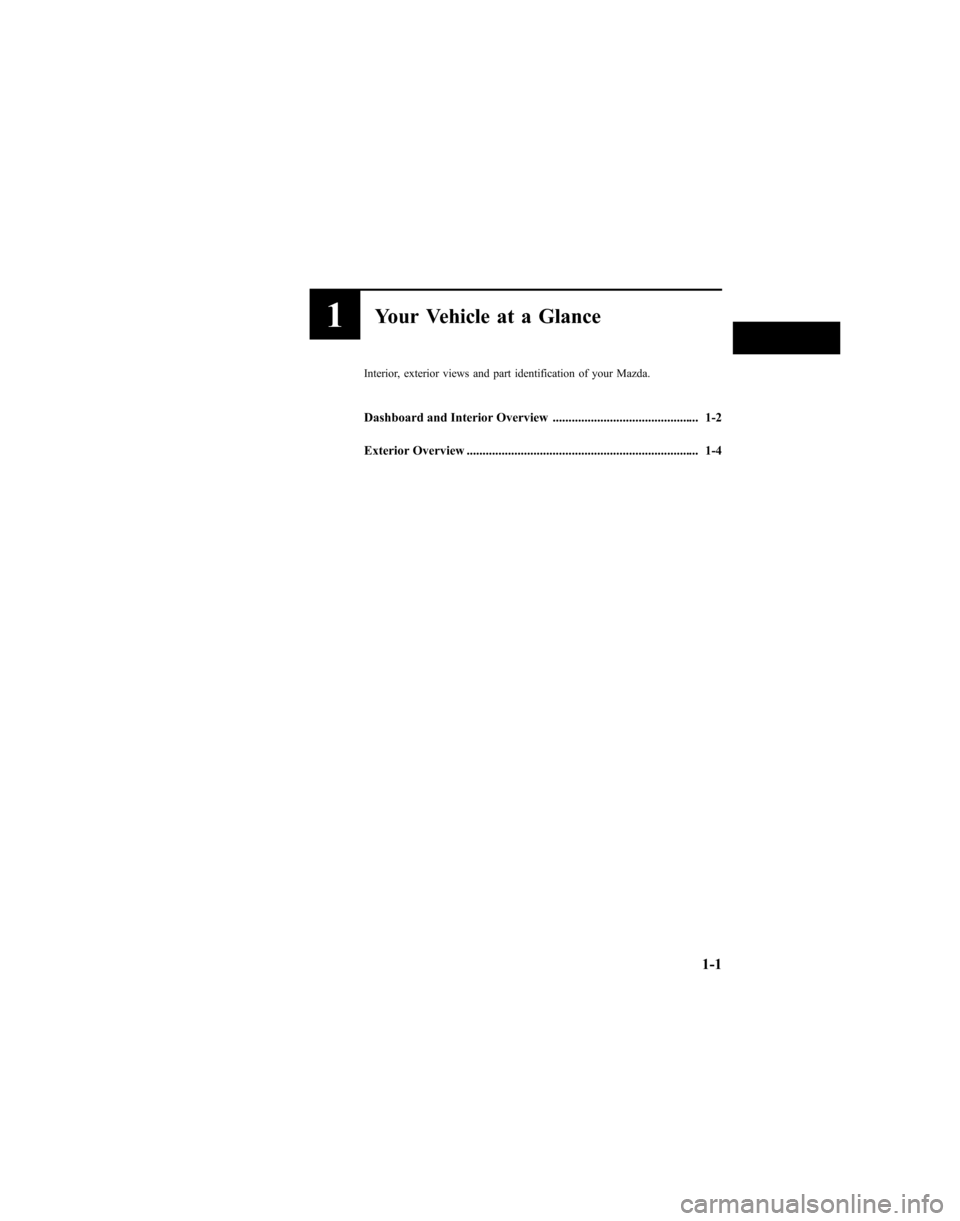
1Your Vehicle at a Glance
Interior, exterior views and part identification of your Mazda.
Dashboard and Interior Overview .............................................. 1-2
Exterior Overview ......................................................................... 1-4
1-1
Page 8 of 340
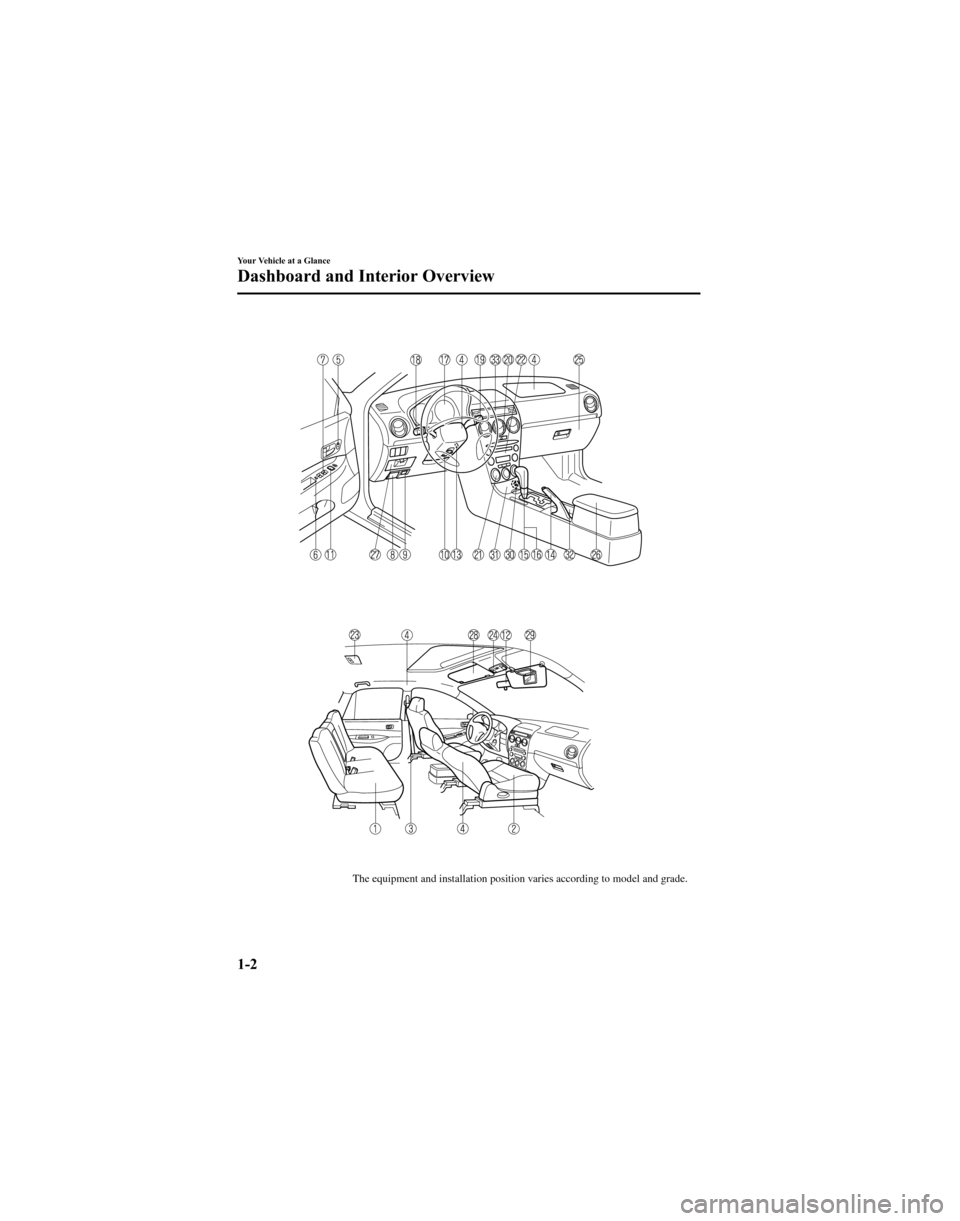
The equipment and installation position varies according to model and grade.
1-2
Your Vehicle at a Glance
Dashboard and Interior Overview
Page 9 of 340
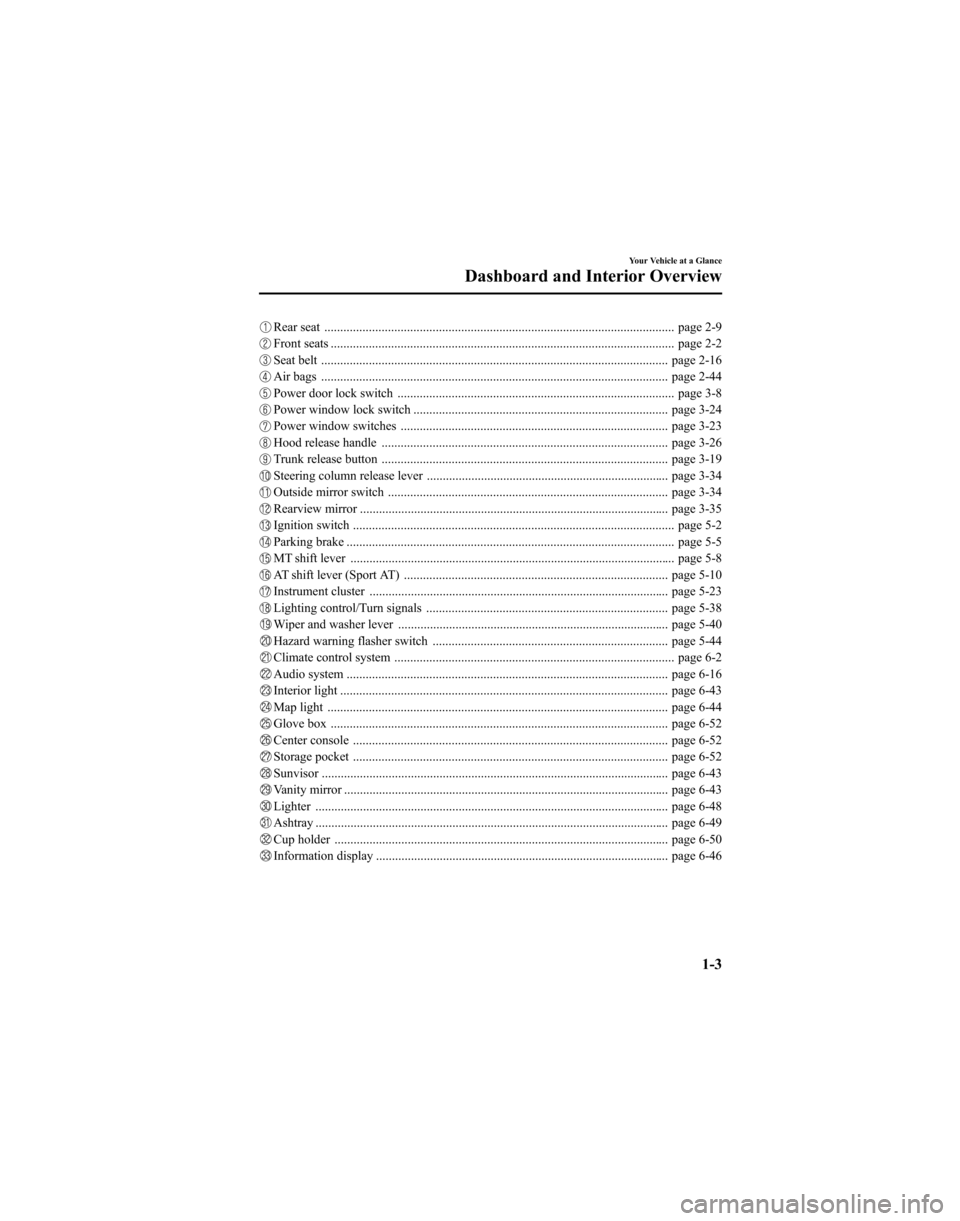
Rear seat .............................................................................................................. page 2-9
Front seats ............................................................................................................ page 2-2
Seat belt ............................................................................................................. page 2-16
Air bags ............................................................................................................. page 2-44
Power door lock switch ....................................................................................... page 3-8
Power window lock switch ................................................................................ page 3-24
Power window switches .................................................................................... page 3-23
Hood release handle .......................................................................................... page 3-26
Trunk release button .......................................................................................... page 3-19
Steering column release lever ............................................................................ page 3-34
Outside mirror switch ........................................................................................ page 3-34
Rearview mirror ................................................................................................. page 3-35
Ignition switch ..................................................................................................... page 5-2
Parking brake ....................................................................................................... page 5-5
MT shift lever ...................................................................................................... page 5-8
AT shift lever (Sport AT) ................................................................................... page 5-10
Instrument cluster .............................................................................................. page 5-23
Lighting control/Turn signals ............................................................................ page 5-38
Wiper and washer lever ..................................................................................... page 5-40
Hazard warning flasher switch .......................................................................... page 5-44
Climate control system ........................................................................................ page 6-2
Audio system ..................................................................................................... page 6-16
Interior light ....................................................................................................... page 6-43
Map light ........................................................................................................... page 6-44
Glove box .......................................................................................................... page 6-52
Center console ................................................................................................... page 6-52
Storage pocket ................................................................................................... page 6-52
Sunvisor ............................................................................................................. page 6-43
Vanity mirror ...................................................................................................... page 6-43
Lighter ............................................................................................................... page 6-48
Ashtray ............................................................................................................... page 6-49
Cup holder ......................................................................................................... page 6-50
Information display ............................................................................................ page 6-46
Your Vehicle at a Glance
Dashboard and Interior Overview
1-3
Page 58 of 340
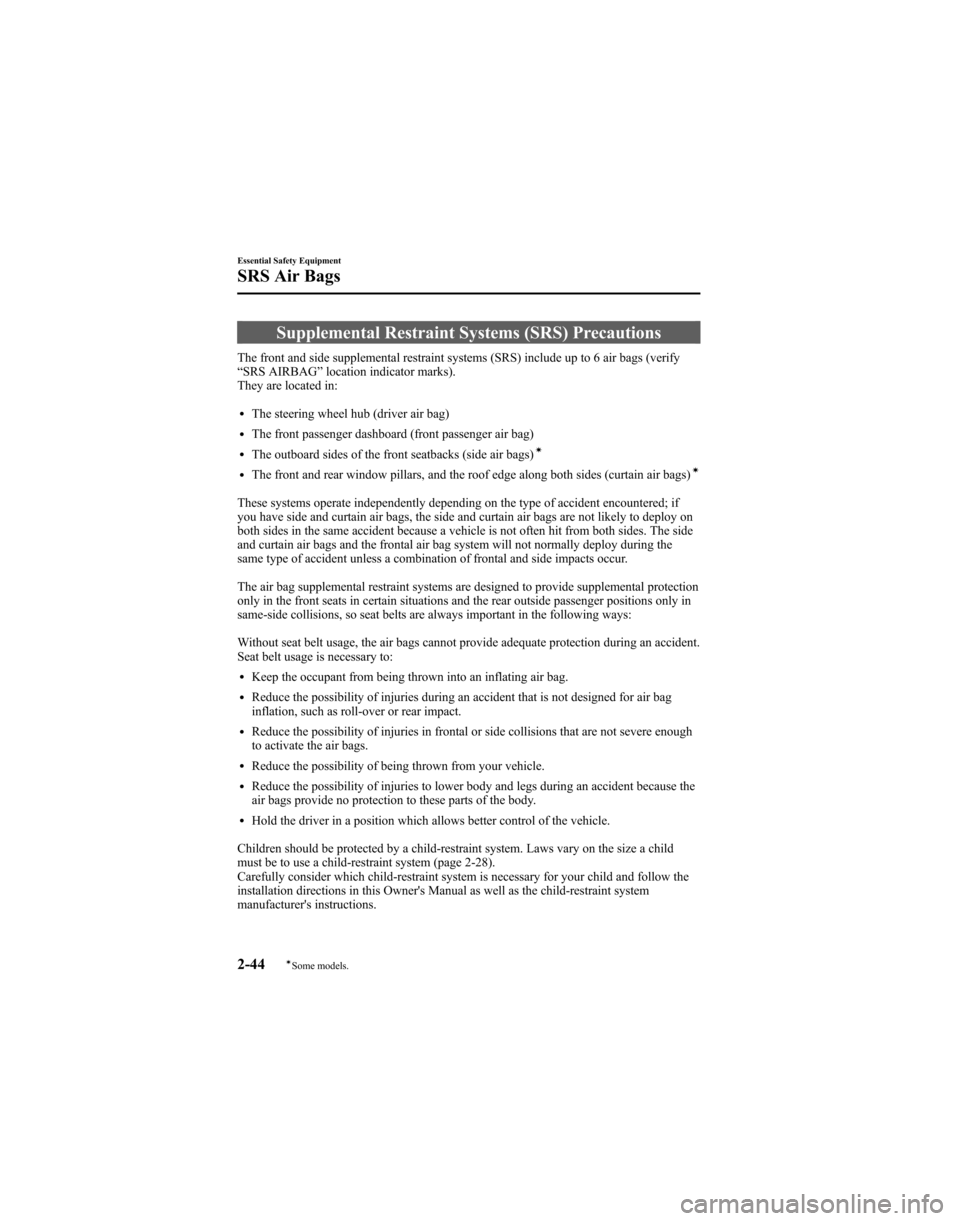
Supplemental Restraint Systems (SRS) Precautions
The front and side supplemental restraint systems (SRS) include up to 6 air bags (verify
“SRS AIRBAG ”location indicator marks).
They are located in:
lThe steering wheel hub (driver air bag)
lThe front passenger dashboard (front passenger air bag)
lThe outboard sides of the front seatbacks (side air bags)í
lThe front and rear window pillars, and the roof edge along both sides (curtain air bags)í
These systems operate independently depending on the type of accident encountered; if
you have side and curtain air bags, the side and curtain air bags are not likely to deploy on
both sides in the same accident because a vehicle is not often hit from both sides. The side
and curtain air bags and the frontal air bag system will not normally deploy during the
same type of accident unless a combination of frontal and side impacts occur.
The air bag supplemental restraint systems are designed to provide supplemental protection
only in the front seats in certain situations and the rear outside passenger positions only in
same-side collisions, so seat belts are always important in the following ways:
Without seat belt usage, the air bags cannot provide adequate protection during an accident.
Seat belt usage is necessary to:
lKeep the occupant from being thrown into an inflating air bag.
lReduce the possibility of injuries during an accident that is not designed for air bag
inflation, such as roll-over or rear impact.
lReduce the possibility of injuries in frontal or side collisions that are not severe enough
to activate the air bags.
lReduce the possibility of being thrown from your vehicle.
lReduce the possibility of injuries to lower body and legs during an accident because the
air bags provide no protection to these parts of the body.
lHold the driver in a position which allows better control of the vehicle.
Children should be protected by a child-restraint system. Laws vary on the size a child
must be to use a child-restraint system (page 2-28).
Carefully consider which child-restraint system is necessary for your child and follow the
installation directions in this Owner's Manual as well as the child-restraint system
manufacturer's instructions.
2-44
Essential Safety Equipment
íSome models.
SRS Air Bags
Page 60 of 340
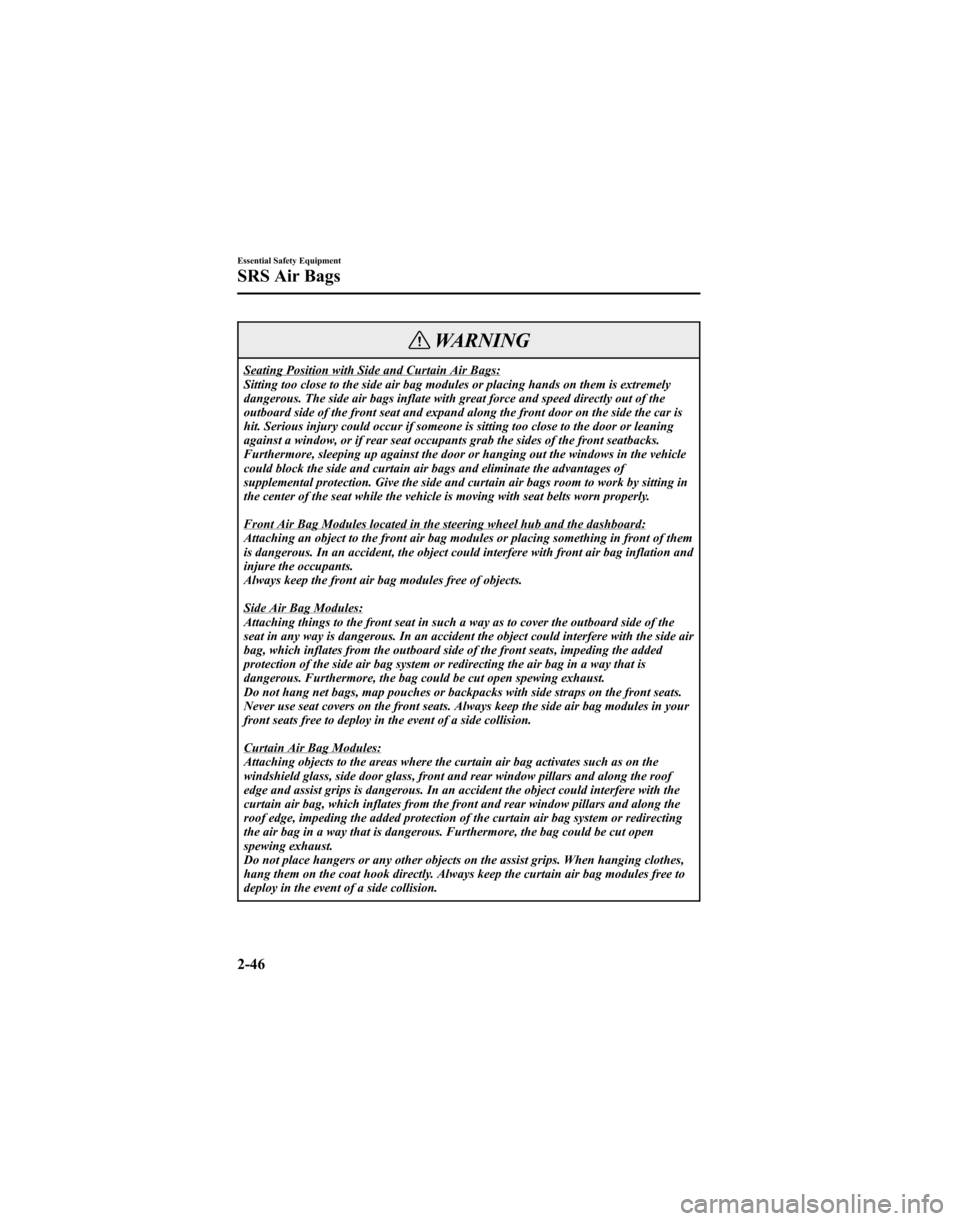
WARNING
Seating Position with Side and Curtain Air Bags:
Sitting too close to the side air bag modules or placing hands on them is extremely
dangerous. The side air bags inflate with great force and speed directly out of the
outboard side of the front seat and expand along the front door on the side the car is
hit. Serious injury could occur if someone is sitting too close to the door or leaning
against a window, or if rear seat occupants grab the sides of the front seatbacks.
Furthermore, sleeping up against the door or hanging out the windows in the vehicle
could block the side and curtain air bags and eliminate the advantages of
supplemental protection. Give the side and curtain air bags room to work by sitting in
the center of the seat while the vehicle is moving with seat belts worn properly.
Front Air Bag Modules located in the steering wheel hub and the dashboard:
Attaching an object to the front air bag modules or placing something in front of them
is dangerous. In an accident, the object could interfere with front air bag inflation and
injure the occupants.
Always keep the front air bag modules free of objects.
Side Air Bag Modules:
Attaching things to the front seat in such a way as to cover the outboard side of the
seat in any way is dangerous. In an accident the object could interfere with the side air
bag, which inflates from the outboard side of the front seats, impeding the added
protection of the side air bag system or redirecting the air bag in a way that is
dangerous. Furthermore, the bag could be cut open spewing exhaust.
Do not hang net bags, map pouches or backpacks with side straps on the front seats.
Never use seat covers on the front seats. Always keep the side air bag modules in your
front seats free to deploy in the event of a side collision.
Curtain Air Bag Modules:
Attaching objects to the areas where the curtain air bag activates such as on the
windshield glass, side door glass, front and rear window pillars and along the roof
edge and assist grips is dangerous. In an accident the object could interfere with the
curtain air bag, which inflates from the front and rear window pillars and along the
roof edge, impeding the added protection of the curtain air bag system or redirecting
the air bag in a way that is dangerous. Furthermore, the bag could be cut open
spewing exhaust.
Do not place hangers or any other objects on the assist grips. When hanging clothes,
hang them on the coat hook directly. Always keep the curtain air bag modules free to
deploy in the event of a side collision.
2-46
Essential Safety Equipment
SRS Air Bags
Page 61 of 340
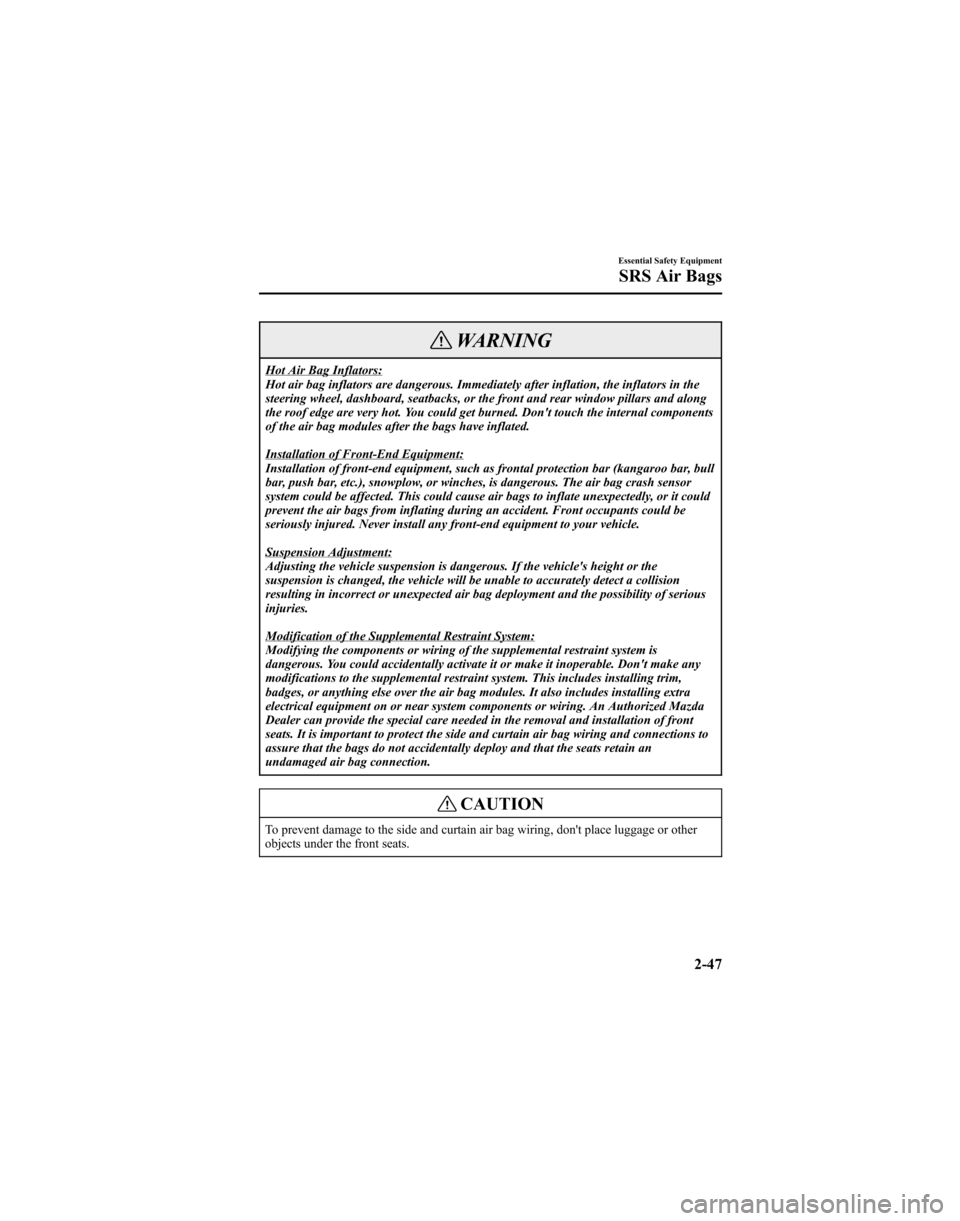
WARNING
Hot Air Bag Inflators:
Hot air bag inflators are dangerous. Immediately after inflation, the inflators in the
steering wheel, dashboard, seatbacks, or the front and rear window pillars and along
the roof edge are very hot. You could get burned. Don't touch the internal components
of the air bag modules after the bags have inflated.
Installation of Front-End Equipment:
Installation of front-end equipment, such as frontal protection bar (kangaroo bar, bull
bar, push bar, etc.), snowplow, or winches, is dangerous. The air bag crash sensor
system could be affected. This could cause air bags to inflate unexpectedly, or it could
prevent the air bags from inflating during an accident. Front occupants could be
seriously injured. Never install any front-end equipment to your vehicle.
Suspension Adjustment:
Adjusting the vehicle suspension is dangerous. If the vehicle's height or the
suspension is changed, the vehicle will be unable to accurately detect a collision
resulting in incorrect or unexpected air bag deployment and the possibility of serious
injuries.
Modification of the Supplemental Restraint System:
Modifying the components or wiring of the supplemental restraint system is
dangerous. You could accidentally activate it or make it inoperable. Don't make any
modifications to the supplemental restraint system. This includes installing trim,
badges, or anything else over the air bag modules. It also includes installing extra
electrical equipment on or near system components or wiring. An Authorized Mazda
Dealer can provide the special care needed in the removal and installation of front
seats. It is important to protect the side and curtain air bag wiring and connections to
assure that the bags do not accidentally deploy and that the seats retain an
undamaged air bag connection.
CAUTION
To prevent damage to the side and curtain air bag wiring, don't place luggage or other
objects under the front seats.
Essential Safety Equipment
SRS Air Bags
2-47
Page 63 of 340
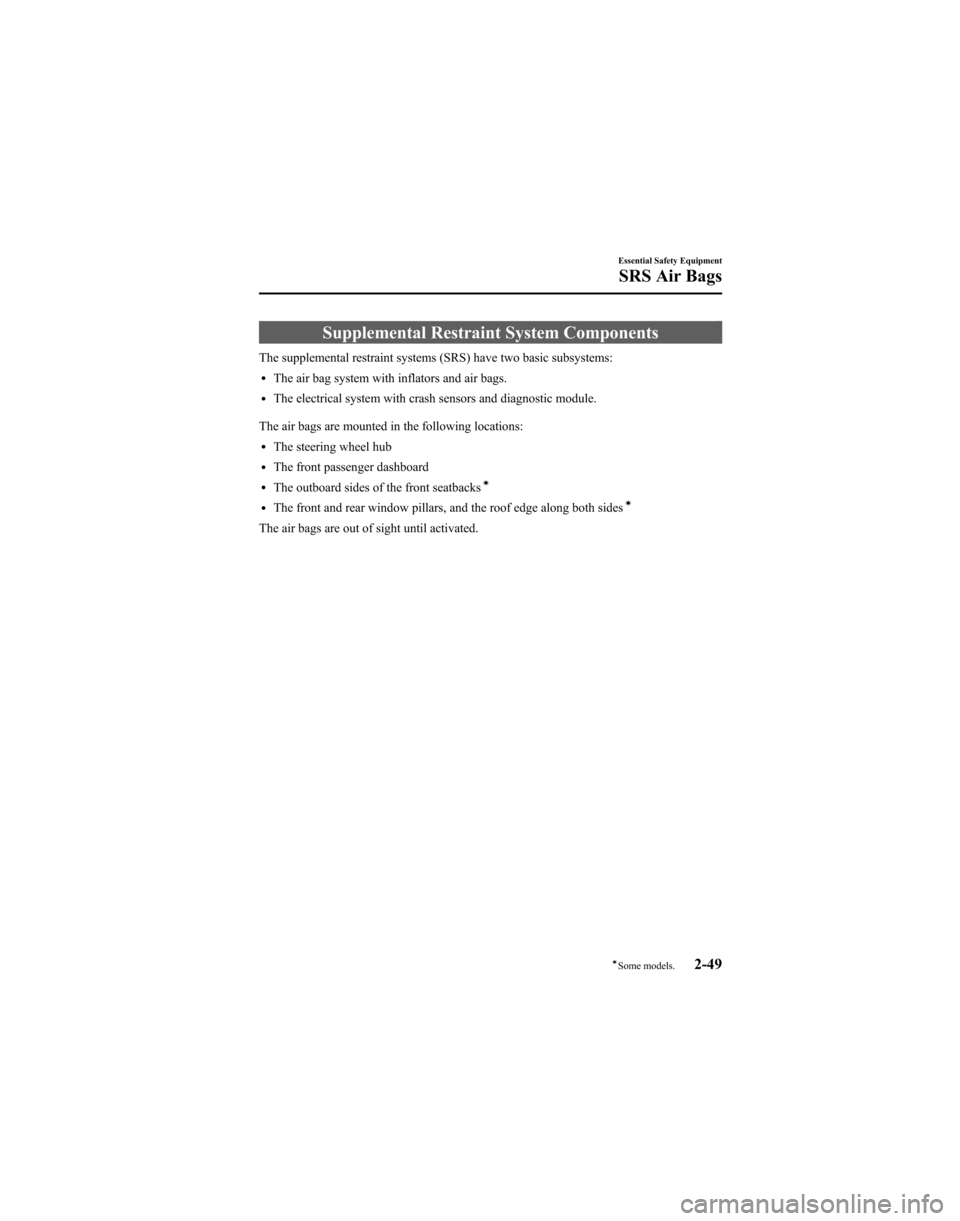
Supplemental Restraint System Components
The supplemental restraint systems (SRS) have two basic subsystems:
lThe air bag system with inflators and air bags.
lThe electrical system with crash sensors and diagnostic module.
The air bags are mounted in the following locations:
lThe steering wheel hub
lThe front passenger dashboard
lThe outboard sides of the front seatbacksí
lThe front and rear window pillars, and the roof edge along both sidesí
The air bags are out of sight until activated.
Essential Safety Equipment
SRS Air Bags
2-49íSome models.
Page 75 of 340
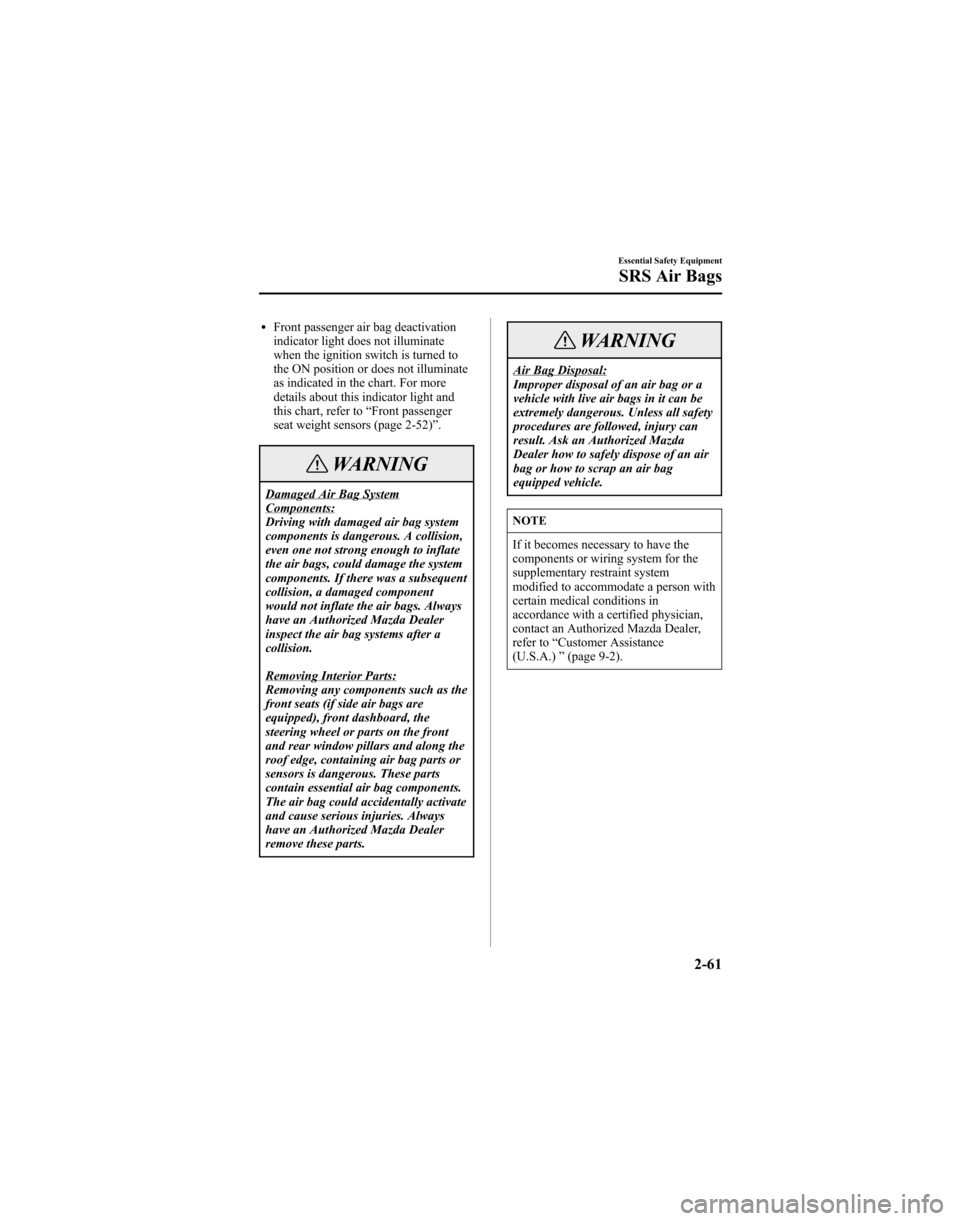
lFront passenger air bag deactivation
indicator light does not illuminate
when the ignition switch is turned to
the ON position or does not illuminate
as indicated in the chart. For more
details about this indicator light and
this chart, refer to“Front passenger
seat weight sensors (page 2-52) ”.
WARNING
Damaged Air Bag SystemComponents:
Driving with damaged air bag system
components is dangerous. A collision,
even one not strong enough to inflate
the air bags, could damage the system
components. If there was a subsequent
collision, a damaged component
would not inflate the air bags. Always
have an Authorized Mazda Dealer
inspect the air bag systems after a
collision.
Removing Interior Parts:
Removing any components such as the
front seats (if side air bags are
equipped), front dashboard, the
steering wheel or parts on the front
and rear window pillars and along the
roof edge, containing air bag parts or
sensors is dangerous. These parts
contain essential air bag components.
The air bag could accidentally activate
and cause serious injuries. Always
have an Authorized Mazda Dealer
remove these parts.
WARNING
Air Bag Disposal:
Improper disposal of an air bag or a
vehicle with live air bags in it can be
extremely dangerous. Unless all safety
procedures are followed, injury can
result. Ask an Authorized Mazda
Dealer how to safely dispose of an air
bag or how to scrap an air bag
equipped vehicle.
NOTE
If it becomes necessary to have the
components or wiring system for the
supplementary restraint system
modified to accommodate a person with
certain medical conditions in
accordance with a certified physician,
contact an Authorized Mazda Dealer,
refer to “Customer Assistance
(U.S.A.) ”(page 9-2).
Essential Safety Equipment
SRS Air Bags
2-61
Page 105 of 340
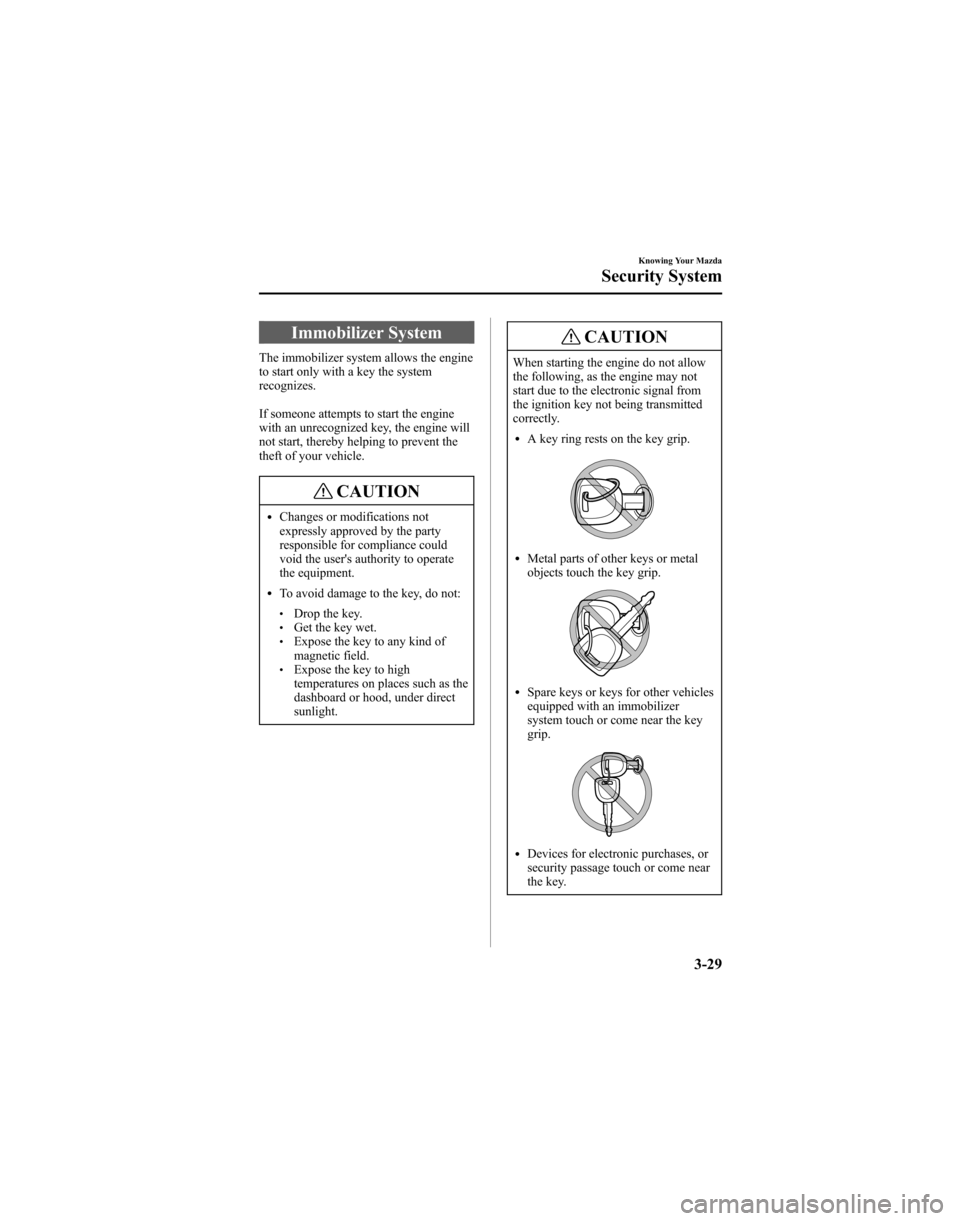
Immobilizer System
The immobilizer system allows the engine
to start only with a key the system
recognizes.
If someone attempts to start the engine
with an unrecognized key, the engine will
not start, thereby helping to prevent the
theft of your vehicle.
CAUTION
lChanges or modifications not
expressly approved by the party
responsible for compliance could
void the user's authority to operate
the equipment.
lTo avoid damage to the key, do not:
lDrop the key.lGet the key wet.lExpose the key to any kind of
magnetic field.
lExpose the key to high
temperatures on places such as the
dashboard or hood, under direct
sunlight.
CAUTION
When starting the engine do not allow
the following, as the engine may not
start due to the electronic signal from
the ignition key not being transmitted
correctly.
lA key ring rests on the key grip.
lMetal parts of other keys or metal
objects touch the key grip.
lSpare keys or keys for other vehicles
equipped with an immobilizer
system touch or come near the key
grip.
lDevices for electronic purchases, or
security passage touch or come near
the key.
Knowing Your Mazda
Security System
3-29
Page 147 of 340
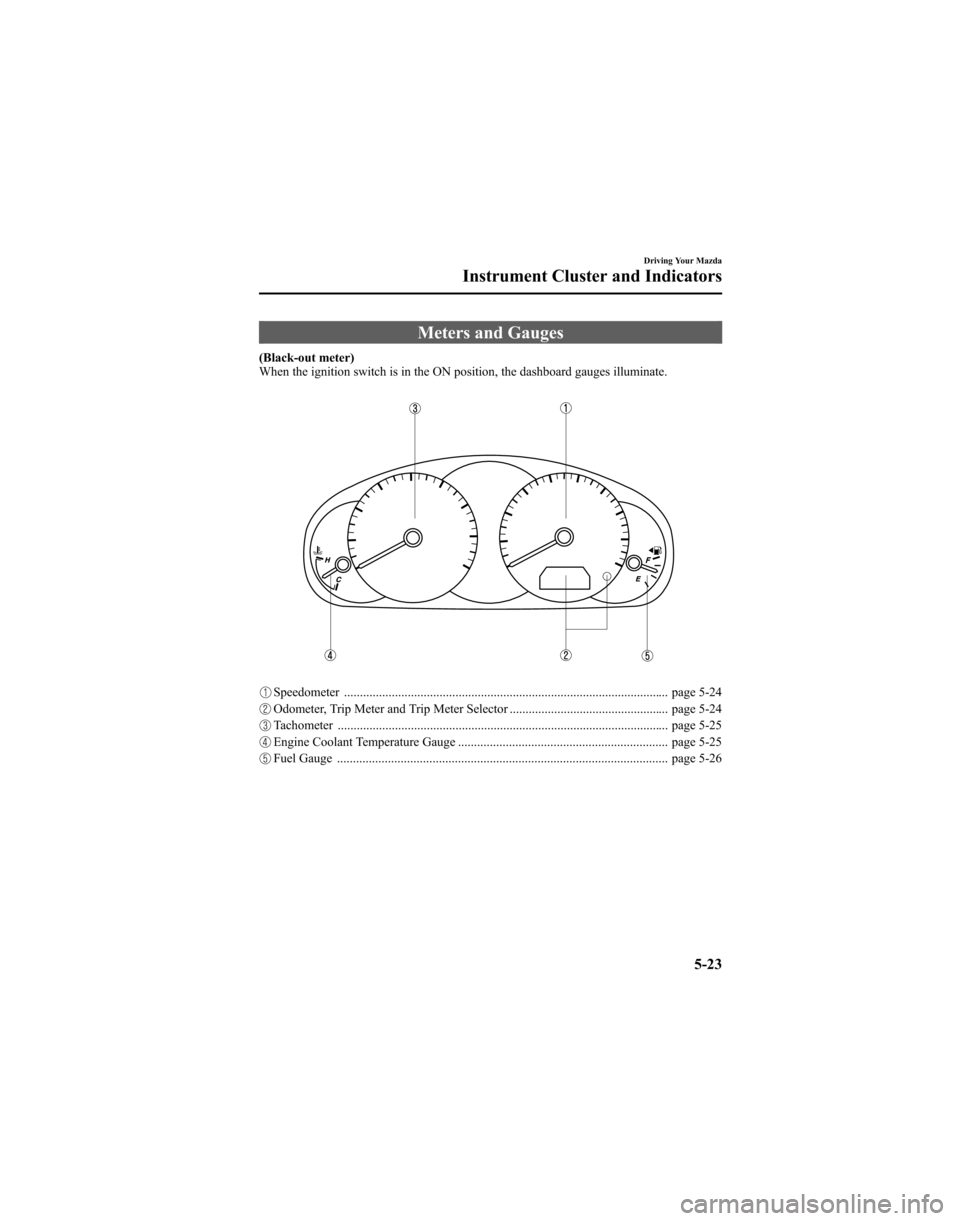
Meters and Gauges
(Black-out meter)
When the ignition switch is in the ON position, the dashboard gauges illuminate.
Speedometer ...................................................................................................... page 5-24
Odometer, Trip Meter and Trip Meter Selector .................................................. page 5-24
Tachometer ........................................................................................................ page 5-25
Engine Coolant Temperature Gauge .................................................................. page 5-25
Fuel Gauge ........................................................................................................ page 5-26
Driving Your Mazda
Instrument Cluster and Indicators
5-23